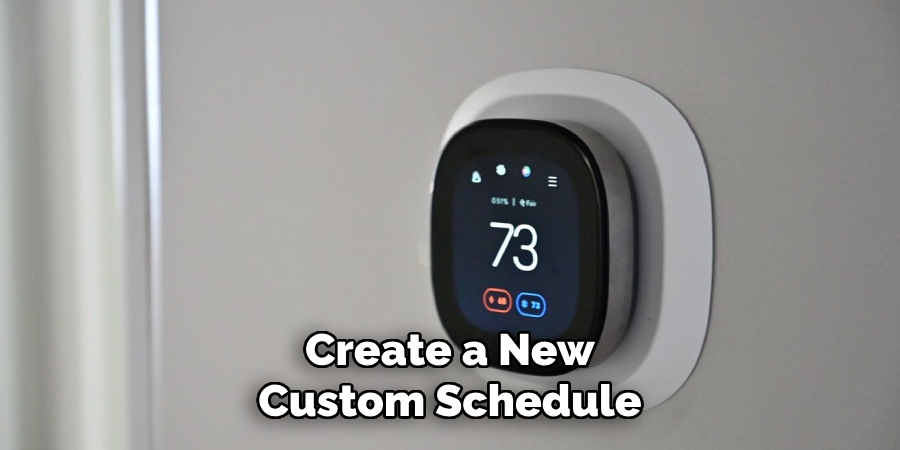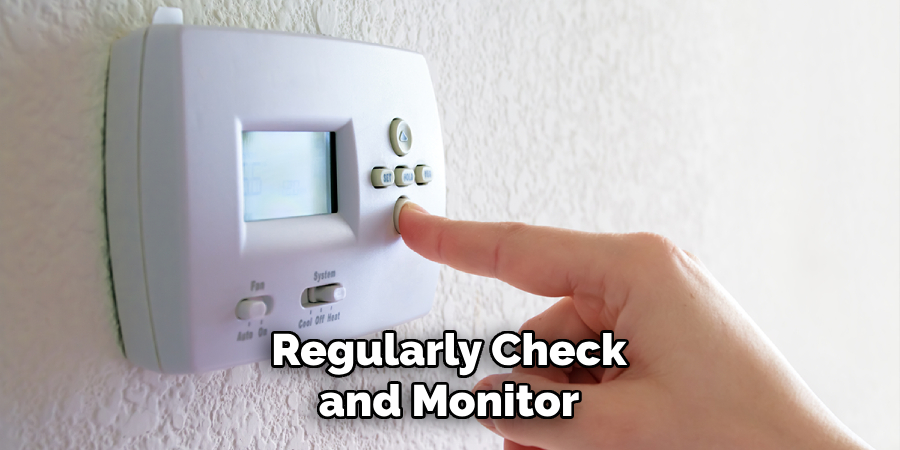Welcome, fellow homeowners and energy-savers! Are you tired of constantly adjusting your thermostat to maintain a comfortable temperature throughout the day? Or maybe you’re looking for ways to reduce your carbon footprint and save on your energy bills.

Well, look no further! In this blog post, we will be discussing how to set nest thermostat to hold temp. This feature allows you to set a specific temperature that stays constant until you manually change it again.
It may seem like a small detail in the grand scheme of things, but making this simple adjustment can make a significant impact on both your comfort and wallet. So sit back, relax, and get ready to learn how to efficiently control the temperature in your home with just one setting on your Nest thermostat.
Necessary Items
Before we dive into the steps to set your Nest thermostat to hold temp, here are a few things you’ll need:
- A Nest thermostat (obviously)
- A stable and reliable WiFi connection
- Your Nest account login information
- Knowledge of how to navigate through your thermostat’s settings (we’ll guide you through it, don’t worry!)
10 Steps on How to Set Nest Thermostat to Hold Temp
Step 1: Access Your Thermostat’s Settings
First things first, you’ll need to access the settings on your Nest thermostat. To do this, simply tap on the thermostat’s display and click on the gear icon in the top right corner. This will take you to the main settings menu.
Step 2: Choose “Thermostat” Settings
From the main settings menu, select “Thermostat” from the list of options. This will bring up a new set of options explicitly related to your thermostat’s functions.
Step 3: Select “Schedule”
Scroll through the options until you see “Schedule” and click on it. This will take you to a screen where you can customize your thermostat’s schedule.
Step 4: Click on “Create Custom”
At the bottom of the schedule screen, you’ll see an option that says “Create Custom.” Select this to create a new custom schedule for your thermostat.

Step 5: Choose the Days You Want to Add a Hold Temp
On the custom schedule screen, you’ll see a list of days of the week. Select the days that you want to set a hold temp for. This can include weekdays, weekends, or specific days throughout the week.
Step 6: Set the Temperature for Your Hold Temp
Once you’ve selected the days, click on each day to set the desired temperature for your hold temp. Keep in mind that this temperature will stay constant until you manually change it again.
Step 7: Select “Next”
After setting the temperature for each day, click on the “Next” button in the bottom right corner.
Step 8: Confirm Your Schedule
Review the schedule that you’ve created and make any necessary changes. Once you’re satisfied, select “Next” again.
Step 9: Name Your Schedule
Give your schedule a name that you’ll quickly recognize, such as “Hold Temp” or “Constant Temperature.” Once you’ve named it, select “Next”.
Step 10: Save and Activate Your Schedule
Finally, click on “Save” to activate your custom schedule. You can also choose to keep this schedule active until you manually change it again or set an end date for it. And that’s it! Your Nest thermostat is now set to hold temp, giving you a constant and comfortable temperature throughout the day.
We hope this step-by-step guide has helped you learn how to set your Nest thermostat to hold temp. This simple adjustment can make a big difference in both your comfort and energy usage, ultimately saving you time and money. Remember, constantly adjust your thermostat accordingly for special circumstances such as vacations or changes in weather.
8 Things to Avoid When Using Hold Temp
Now that you know how to set your Nest thermostat to hold temp, here are a few things to avoid when utilizing this feature:
1. Leaving the Temperature Too High or Low for Comfort
It’s essential to find a comfortable temperature for you and your family. If the hold temp is set too high or low, it can make your home uncomfortable and defeat the purpose of using this feature.

2. Forgetting to Turn Off Hold Temp When Not Needed
Be mindful of when you may not need a constant temperature, such as when you’re away from home or during mild weather. Make sure to turn off the hold temp in these situations to conserve energy and save on your bills.
3. Setting Too Many Days for Hold Temp
If you set too many days for hold temp, you may save energy on days when it’s not necessary. Be selective and only set the hold temp for days that are consistent in terms of temperature and your household’s schedule.
4. Not Adjusting Hold Temp for Changes in Weather
While holding temp can save you time and effort, it’s essential to adjust it accordingly when the weather changes. This will not only keep your home at a comfortable temperature but also help you save on energy costs.
5. Neglecting to Set an End Date
If you choose to set an end date for your hold temp schedule, make sure to choose a reasonable date that aligns with your household’s routine and the current weather forecast. This will ensure that you’re using energy and money effectively on days when hold temp is no longer needed.
6. Failing to Check for Software Updates
Nest thermostats regularly receive software updates that can improve its performance and efficiency. Make sure to check for updates periodically to ensure your thermostat is running at its best.
7. Not Using the “Auto-Schedule” Feature
Nest thermostats also have an “Auto-Schedule” feature that can learn your preferred temperature settings and automatically adjust them for you. Be sure to take advantage of this feature for maximum convenience and energy savings.
8. Overriding Hold Temp Too Often
While it’s convenient to be able to adjust the hold temp manually, try to override it sparingly. This can lead to wasted energy and defeat the purpose of using this feature in the first place.
By avoiding these common mistakes, you’ll be able to effectively use and benefit from setting your Nest thermostat to hold temp. As always, make sure to regularly check and monitor your thermostat’s settings for optimal performance and comfort.

Frequently Asked Questions
Will My Nest Thermostat Automatically Switch to Hold Temp on Vacation Mode?
No, if you want your thermostat to remain on hold temp while you’re away on vacation, you will need to manually set the hold temp before leaving.
Can I Still Use the “Away” Feature with Hold Temp?
Yes, you can still use the “Away” feature with hold temp. Simply set your desired temperature for when you’re away and then activate hold temp to maintain that temperature until you return.
Is There a Limit to How Many Schedules I Can Create?
No, there is no limit to the number of schedules you can create on your Nest thermostat. You can customize and save as many schedules as you need for different days or occasions.
Can I Edit or Delete a Custom Schedule?
Yes, you can edit or delete a custom schedule at any time by going to the “Schedule” screen in your thermostat settings. Simply select the schedule you want to change and make your adjustments accordingly.
What Happens if I Don’t Set an End Date for My Hold Temp Schedule?
If you don’t set an end date for your hold temp schedule, it will continue to stay active until you manually turn it off or set a new program. Keep this in mind when creating your schedules to avoid unnecessary energy usage.
Can I Set Different Hold Temps for Different Days?
Yes, when creating a custom schedule for hold temp, you can choose different temperatures for each day of the week. This allows for maximum customization and comfort for your household’s routine.
Can I See the Energy Savings from Using Hold Temp?
Yes, you can view your energy usage and savings through the Nest app or on your thermostat’s display screen. This will give you a better understanding of how hold temp impacts your overall energy consumption.
Overall, setting your Nest thermostat to hold temp is a simple but effective way to maintain a comfortable and energy-efficient home. By avoiding common mistakes and regularly monitoring your settings, you can maximize the benefits of this feature. Stay comfortable and save money with the hold temp on your Nest thermostat.

Conclusion
Setting your Nest thermostat to hold temp is a simple yet effective way to save on energy costs and maintain a comfortable temperature in your home. Utilizing the hold temp feature on your Nest thermostat can significantly affect your home’s comfort and energy usage. By avoiding common mistakes on how to set nest thermostat to hold temp and regularly monitoring your thermostat’s settings, you can maximize the benefits of setting your Nest thermostat to hold temp.
Now, go ahead and enjoy consistent temperatures and savings on your energy bills! So remember to use this helpful feature for a more comfortable and cost-effective living experience with your Nest thermostat. So, go ahead and try out the hold temp feature today!
You Can Check It Out to Cool Multiple Rooms With One AC
